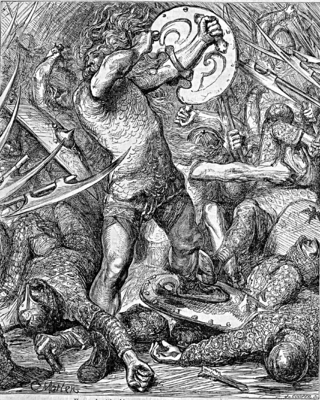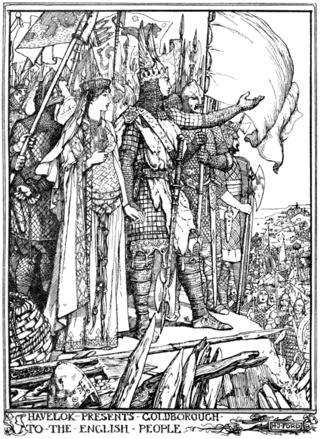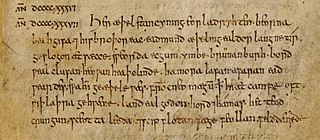
English mythology is the collection of myths that have emerged throughout the history of England, sometimes being elaborated upon by successive generations, and at other times being rejected and replaced by other explanatory narratives. These narratives consist of folk traditions developed in England after the Norman Conquest, integrated with traditions from Anglo-Saxon mythology, Christian mythology, and Celtic mythology. Elements of the Matter of Britain, Welsh mythology and Cornish mythology which relate directly to England are included, such as the foundation myth of Brutus of Troy and the Arthurian legends, but these are combined with narratives from the Matter of England and traditions from English folklore.

The Anglo-Saxons were a cultural group that inhabited much of what is now England in the Early Middle Ages, and spoke Old English. They traced their origins to Germanic settlers who came to Britain from mainland Europe in the 5th century. Although the details are not clear, their cultural identity developed out of the interaction of these settlers with the pre-existing Romano-British culture. Over time, most of the people of what is now southern, central, northern and eastern England came to identify as Anglo-Saxon and speak Old English. Danish and Norman invasions later changed the situation significantly, but their language and political structures are the direct predecessors of the medieval Kingdom of England, and the Middle English language. Although the modern English language owes somewhat less than 26% of its words to Old English, this includes the vast majority of words used in everyday speech.

Hereward the Wake was an Anglo-Saxon nobleman and a leader of local resistance to the Norman Conquest of England. His base when he led the rebellion against the Norman rulers was the Isle of Ely, in eastern England. According to legend, he roamed the Fens, which covers parts of the modern counties of Cambridgeshire, Lincolnshire and Norfolk, and led popular opposition to William the Conqueror.

The Matter of Britain is the body of medieval literature and legendary material associated with Great Britain and Brittany and the legendary kings and heroes associated with it, particularly King Arthur. The 12th-century Welsh cleric Geoffrey of Monmouth's Historia Regum Britanniae, widely popular in its day, is a central component of the Matter of Britain.
According to the medieval poet Jean Bodel, the Matter of Rome is the literary cycle of Greek and Roman mythology, together with episodes from the history of classical antiquity, focusing on military heroes like Alexander the Great and Julius Caesar. Bodel's division of literary cycles also included the Matter of France and the Matter of Britain. The Matter of Rome includes the Matter of Troy, consisting of romances and other texts based on the Trojan War and its legacy, including the adventures of Aeneas.
Jean Bodel, was an Old French poet who wrote a number of chansons de geste as well as many fabliaux. He lived in Arras.

Anglo-Saxon architecture was a period in the history of architecture in England from the mid-5th century until the Norman Conquest of 1066. Anglo-Saxon secular buildings in Britain were generally simple, constructed mainly using timber with thatch for roofing. No universally accepted example survives above ground. Generally preferring not to settle within the old Roman cities, the Anglo-Saxons built small towns near their centres of agriculture, at fords in rivers or sited to serve as ports. In each town, a main hall was in the centre, provided with a central hearth.

Guy of Warwick, or Gui de Warewic, is a legendary English hero of Romance popular in England and France from the 13th to 17th centuries, but now largely forgotten. The story of Sir Guy is considered by scholars to be part of the Matter of England.

Havelok the Dane, also known as Havelok or Lay of Havelok the Dane, is a thirteenth-century Middle English romance considered to be part of the Matter of England. The story, however, is also known in two earlier Anglo-Norman versions, one by Geffrei Gaimar and another known as the Lai d'havelok. The name "Havelok" also has many variations in spelling, and can be found as "Haveloc", "Havelock", or "Aybloc".
The Proverbs of Alfred is a collection of early Middle English sayings ascribed to King Alfred the Great, said to have been uttered at an assembly in Seaford, East Sussex. The collection of proverbs was probably put together in Sussex in the mid-12th century. The manuscript evidence suggests the text originated at either a Cluniac or Benedictine monastery, either Lewes Priory, 10 mi (16 km) to the north of Seaford, or Battle Abbey, 25 mi (40 km) to the north-east.

Bevis of Hampton (Old French: Beuve(s) or Bueve or Beavisde Hanton(n)e; Anglo-Norman: Boeve de Haumtone; Italian: Buovo d'Antona) or Sir Bevois was a legendary English hero and the subject of Anglo-Norman, Dutch, French, English, Venetian, and other medieval metrical chivalric romances that bear his name. The tale also exists in medieval prose, with translations to Romanian, Russian, Dutch, Irish, Welsh, Old Norse and Yiddish.

As a literary genre, the chivalric romance is a type of prose and verse narrative that was popular in the noble courts of high medieval and early modern Europe. They were fantastic stories about marvel-filled adventures, often of a chivalric knight-errant portrayed as having heroic qualities, who goes on a quest. It developed further from the epics as time went on; in particular, "the emphasis on love and courtly manners distinguishes it from the chanson de geste and other kinds of epic, in which masculine military heroism predominates."
The term Middle English literature refers to the literature written in the form of the English language known as Middle English, from the late 12th century until the 1470s. During this time the Chancery Standard, a form of London-based English, became widespread and the printing press regularized the language. Between the 1470s and the middle of the following century there was a transition to early Modern English. In literary terms, the characteristics of the literary works written did not change radically until the effects of the Renaissance and Reformed Christianity became more apparent in the reign of King Henry VIII. There are three main categories of Middle English literature, religious, courtly love, and Arthurian, though much of Geoffrey Chaucer's work stands outside these. Among the many religious works are those in the Katherine Group and the writings of Julian of Norwich and Richard Rolle.

Medieval French literature is, for the purpose of this article, Medieval literature written in Oïl languages during the period from the eleventh century to the end of the fifteenth century.
King Horn is a Middle English chivalric romance dating back to the middle of the thirteenth century. It survives in three manuscripts: London, British Library, MS. Harley 2253; Oxford, Bodleian Library, MS. Laud. Misc 108; and Cambridge, Cambridge University Library, MS. Gg. iv. 27. 2. It is thought to be based on the Anglo-Norman Romance of Horn (1170). The story was retold in later romances and ballads, and is considered part of the Matter of England. The poem is currently believed to be the oldest extant romance in Middle English.
Henry Royston Loyn, FBA, was a British historian specialising in the history of Anglo-Saxon England. His eminence in his field made him a natural candidate to run the Sylloge of the Coins of the British Isles, which he chaired from 1979 to 1993. He was Professor of Medieval History in the University College of South Wales and Monmouthshire and afterwards Professor of Medieval History at Westfield College in the University of London.
The Karlamagnús saga, Karlamagnussaga or Karlamagnus-saga was a late-thirteenth-century Norse prose compilation and adaptation, made for Haakon V of Norway, of the Old French chansons de geste of the Matter of France dealing with Charlemagne and his paladins. In some cases, the Karlamagnús saga remains the only source for otherwise-lost Old French epics.

The literature of England is literature written in what is now England, or by English writers. It consists mainly of English literature - i.e. literature written in the English language - but there are important examples of literature from England written in other languages.

The "Battle of Brunanburh" is an Old English poem. It is preserved in the Anglo-Saxon Chronicle, a historical record of events in Anglo-Saxon England which was kept from the late ninth to the mid-twelfth century. The poem records the Battle of Brunanburh, a battle fought in 937 between an English army and a combined army of Scots, Vikings, and Britons. The battle resulted in an English victory, celebrated by the poem in style and language like that of traditional Old English battle poetry. The poem is notable because of those traditional elements and has been praised for its authentic tone, but it is also remarkable for its fiercely nationalistic tone, which documents the development of a unified England ruled by the House of Wessex.

Athelston is an anonymous Middle English verse romance in 812 lines, dating from the mid or late 14th century. Modern scholars often classify it as a "Matter of England" romance, because it deals entirely with pre-Conquest English settings and characters. It is mainly written in twelve-line stanzas rhyming AABCCBDDBEEB, though the poet occasionally varies his meter with stanzas of eight, six, or four lines. The poem survives in only one manuscript, the early 15th-century Gonville and Caius MS 175, which also includes the romances Richard Coer de Lyon, Sir Isumbras and Beves of Hamtoun. It has no title there. Athelston was first printed in 1829, when C. H. Hartshorne included it in his Ancient Metrical Tales.












